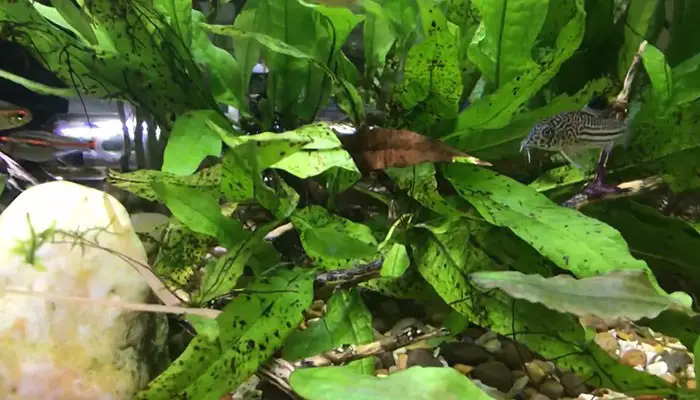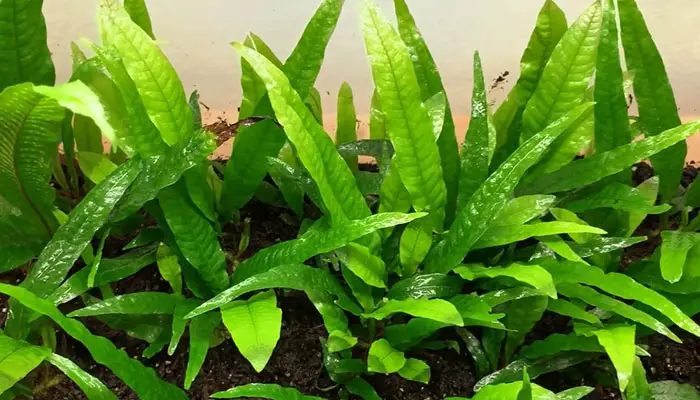How To Deal With Black Spots On Java Fern [Prevention & Cure]
Java fern is one of the most used plants for aquariums around the globe, it’s most likely to be in your ones as well. Moreover, the aquarium fish also love to swim through these plants. Hence, the Java fern reproduces on its own.
It requires very little care to grow them. Any light is fine with these. Apart from sustainability, if you notice black spots on them, you must be worried. Let us give you a hand regarding that.
The positive reason for black spots on your java fern is that your plant is going to have new buds. If not, then you might have issues with light intensity, water parameters, nutrition levels, or even algae attacks.
Don’t freak out noticing black spots on your java fern. They might be there to give you new buds as well.
Causes and Fixes of Black Spots on Java Fern

This is very natural to notice black spots on your Java fern. Though they seem to be problematic at first, you’d be happy to know that these black spots mean new buds on your plant within a week or two. Otherwise, let’s dig into some probabilities and ensure the treatment accordingly.
1. Light Intensity
Even though java fern works fine with almost any light, it might be an issue for your plants out of the inaccurate intensity dials from the lighting units. In such cases, your plants will start to have black or brown spots on them.
In some cases, this scenario is referred to as burning the Java fern. This occurs mostly because of using cheap lighting units in your fish tank. These units tend to have inaccurate intensity dials. Even after setting a suitable intensity level, using a cheaper lighting unit will end up burning your Java fern.
Measures
As you know java fern needs at least 06 hours of light a day, you need to keep in mind that the lighting must not exceed 12 hours and let your plants rest a bit too.
Regarding light intensity, 1.5 watts per gallon of water is suitable for your java fern. If you keep the intensity level low, you need to keep the light turned on for a while longer than the required one.
Use bulbs with higher watts having 5000K to 7500K in their spectrum for these plants. Place your java fern initially closer to the bulbs and then move them closer to far away from the bulbs according to the response.
In the case of choosing a lighting unit, you may consider the Hygger Auto On-Off LED Aquarium Light. It will perfectly ensure your light intensity adjusting levels and prevent you from the dark or brown spots on them.
Applying the above-mentioned measures, you will find the concerned spots fading away from your Java fern eventually.
2. Water Parameters
If you find black or brown spots on your java fern and see them spreading on the leaves or smaller dots getting larger, there might be an issue with the water in your tank. There might be an imbalance in the pH level or the carbon-dioxide level.
This imbalance tends to prevent Java ferns from having proper energy for them. They will lack in the photosynthesis system. Lack of food will escalate to producing dead cells. And that will result in black spots or brown spots on your java fern leaves.
Measures
Issues with water are more likely easy to deal with as water changes from time to time. Still, you need to keep an eye open for the carbon dioxide level and pH level as well.
You need to make sure the carbon dioxide injection level remains below 30 ppm. Otherwise, there will be an imbalance between the ratio of oxygen and carbon dioxide.
Plants only use carbon dioxide when the lights are on, so maintain your injection time according to that.
You can choose the mentioned CO2 system for your convenience.
In terms of maintaining the pH level, keep it between 6.0 to 7.5 with an alkalinity of 3-8 dKH. Java fern survives a wide range of pH levels but for keeping things in order, and to get rid of the black or brown spots or leaves burning out, 6.0 – 7.5 pH works best.
Check the pH level that serves your purpose best. (Our Pick: VIVOSUN 3-in-1 Digital pH Meter)
3. Nutrition Levels
You might face a bunch of brown or black spots on your java fern and find them spreading so rapidly. In such a scenario, it’s most likely because of the lack of nutrition in your aquarium.
This happens if you are up to too many water changes or you change too much of the tank water in a comparatively more frequent time.
Moreover, the lack of fertilizing the tank properly while ensuring the micro and macro ratio can also cause a defect in the nutrition level of the tank water.
Measures
Refrain from changing the tank water too frequently. Also, ensure no unwanted plants grow in your tank otherwise your required fertilizer amount will differ. Moreover, your java ferns will start lacking in proper nutrition.
Use some fertilizers on a regular basis, and try some liquid fertilizers which are really handy for the plants. Ensure some fertilizers which include potassium. (Our Pick: NilocG Aquatics Aquarium Plant Fertilizer)
In terms of brown leaf edges or dead leaves, get rid of them to prevent the further spreading of the spots.
4. Black Beard Algae
Black beard algae might also give you a headache by growing on your java fern. They appear in different colors like black, dark gray, and dark green. If you notice black spots followed by fluffy turfs on the surface of your java fern, it’s because of the algae growing.
The reason behind this algae growth may be too much light, deficiency in CO2 level, or high pollutants in the tank water. Excess of nutrients might also trigger them.
Transferring plants from the suffering tank will not help you, rather might make the situation worse by spreading them in the water tank.
Measures
Go for 3% hydrogen peroxide and soak the affected plant to get rid of the algae. Dip the plant into the solution for 2-3 mins. You may also try regulating the amount of phosphate in your aquarium by reducing it.
Another effective way to add black algae eater fish to your tank. (Our Pick: API ALGAEFIX Algae Control)
Increase the CO2 supply which really barriers the growth of this black algae. Combined with the phosphate and CO2 maintenance, along with the algae eater fish in your tank, you may get rid of this algae.
Ensure not to bring in any sort of plants that are already affected by this algae. If they grow on rocks or such platforms, you may brush them with a daily dose of liquid carbon with a tiny paintbrush.
Cut off the severely affected leaves to get rid of further succession. You may also scrub the leaf surface to make it free from the algae with a stiff toothbrush or a wire brush.
How To Propagate Java Fern (A Quick Guide)

Propagation or breeding of plants is necessary to keep hold of a plant for a longer period. It includes germinating seeds, cutting roots, and splitting new bulbs or rhizomes.
In terms of Java fern, you will find the breeding process very simple and easy to go. You can apply the DIY method without any help from an expert or so.
You would be amazed to know that the Java fern propagates itself on its own. After a certain while after planting them, you will notice plantlets growing on the edge of the leaves. Give the parent plant a while to grow some leaves on the plantlets along with some trailing roots. They seem like java ferns growing roots on their leaves.
After that, you may simply pull the plantlets off the mother plant and place them on any driftwood or other decor or wherever you feel like. They will start to grow there without causing you much hassle.
In another way, you may also try to propagate Java fern with rhizomes. All you need to do is to cut off a part of the rhizome with some leaves attached to it and then place them in your desired section.
Every single cut off rhizome piece will start to grow like an individual Java fern plant. Just attach them to any surface according to your wish, and that’s all!
Narrow leaf java fern attaches itself to any surface and starts growing on its own while also propagating new java spores in due time. They work fine in both immersed and submerged conditions. They may even live in brackish water!
Frequently Asked Questions (FAQs)
How Do I Get Rid Of Brown Spots On My Java Fern?
If you notice your established java fern is turning brown, it’s because of the imbalance of the tank environment. Considering that the java fern is very resistant to disease, you should worry about the other adjusting factors like light intensity, nutrient levels, water parameters, and growth of black algae in your tank. Take proper care of these sectors and get rid of your issue accordingly.
Should I Cut Off Brown Java Fern Leaves?
A java fern is not much different from other fish tank plants. In case your tank environment gets tampered with for any non-adjustment in the considerable factors, you might face your java fern having brown leaves. Getting rid of the very leaves will ensure the further escalation of the issue in your tank.
How Do I Know If My Java Fern Is Healthy?
While choosing a java fern for your tank, you must ensure that you are buying the healthy one. Double check the plant for any brown edge leaf. The entire leaf is supposed to be bright green to dark green. Be aware of any black spots. Check the rhizomes whether are dark green or not. Any browning in the rhizomes indicates unhealthy rhizomes.
Why Is My Java Fern Slowly Losing Its Leaves And Dying?
If you find lots of pinholes in the leaves of your java fern, along with some yellow or brown leaves, there must be an issue with the environment of the tank. If a java fern grows plantlets at an unusual excess rate or stops growing new leaves, you must ensure the nutrient levels remain intact in your tank. Take proper care of the water parameters and save your plant eventually.
Conclusion
Java fern is popular in fish tanks around the globe because of its unique beauty and compatibility. It requires very little care from you to grow.
Some basic stuff like light intensity, water parameters, nutrient level, etc. is related to the health of this plant. Any continuous imbalance may cause you to suffer from leaf loss, black spots, brown edges, or even a hamper in the self-propagation system.
Refrain from changing water too much to keep your tank water enriched in nutrients. Keep fertilizing on a regular basis and pour the required CO2 on a daily basis.
Little but proper maintenance will offer you a healthy and beautiful java fern for your tank. Breed them according to your convenience.
- Temperature Fluctuations And Oto Health – Your Essential Guide To - December 26, 2025
- Synodontis Catfish Bloated Belly Causes – Your Essential Guide To - December 26, 2025
- Zebra Otocinclus Care Guide – The Ultimate Guide To A Thriving, - December 26, 2025
